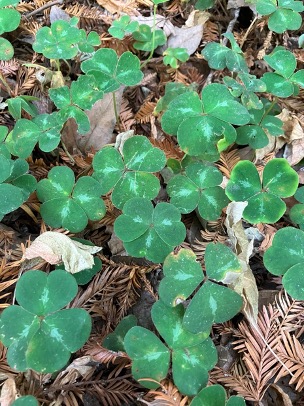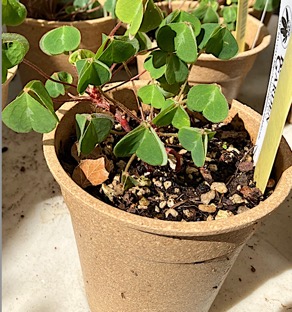
Garden Director Lew Feldman
The Garden’s Mather Redwood Grove is part of the California collection and contains over 450 coast redwoods (Sequoia sempervirens). Given that the trees in the Grove are planted so densely, I am often asked how the understory plants, such as Oxalis oregana (wood sorrel), are able to capture enough sunlight for photosynthesis. Part of the answer relates to the orientation of the leaves (each leaf consists of three leaflets), with each leaflet positioned horizontally (as pictured below), thereby maximizing the surface area available to capture what little light makes it to the forest floor. This feature, coupled with the adaptation of the photosynthetic machinery to function in low light, makes it possible for Oxalis to thrive in the forest understory.

Leaflets oriented horizontally in the deep shade of the Redwood Grove understory.
A Beam of Sunlight
Occasionally, however, a beam of sunlight will be unobstructed by the tree canopy and penetrate to the forest floor, creating a sunfleck, an area of the forest floor illuminated by direct sunlight. In these circumstances, the shade-adapted photosynthetic mechanism, as a consequence of being exposed to very bright light, could be damaged or greatly impaired. But the plant has a mechanism to avoid possible injury. When a sunfleck illuminates a plant, the leaflets are rapidly repositioned from a horizontal to a vertical (downward) orientation, thereby decreasing the amount of surface area available to absorb the potentially damaging, sudden, high intensity light.

Oxalis oregana plants exposed briefly to direct sunlight; leaflets vertical
Researchers have shown that the mechanism for leaflet collapse results from rapid water loss, similar to wilting. Leaflet orientation is reversible with the passing of the sunfleck, or by moving the plants from bright light to shade.
